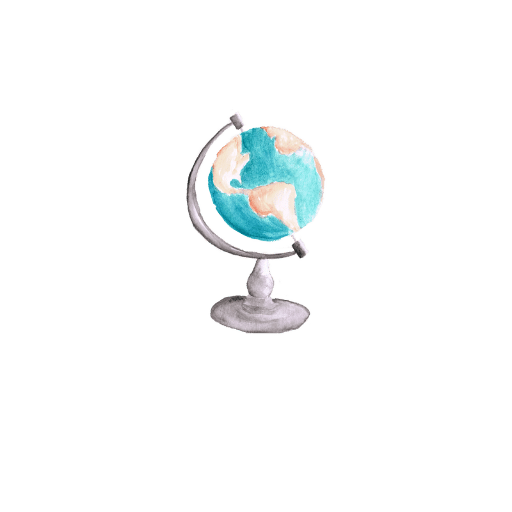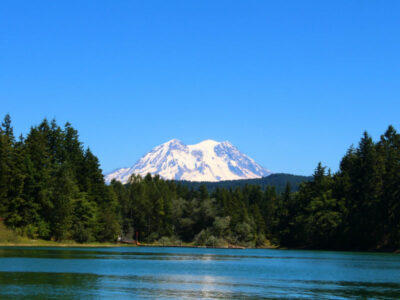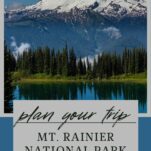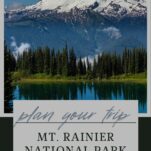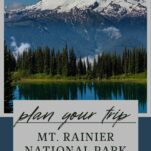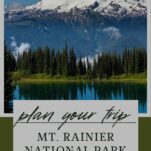Make the Most of Your Trip
Use this guide to plan your trip to Mt. Rainer.
What is Mt. Rainier National Park?
Mt. Rainier National Park is in Washington state, southeast of Seattle. The park covers 369 square miles. The glacier-capped peak is 14,410 feet. The highest point reachable by car is at 6400-foot Sunrise peak. The park is open year-round and offers four seasons of outdoor recreation.
8 things to do at Mt. Rainier National Park
One
Hiking
10 Easy hikes at Mt. Rainier National Park:
1. Trail of Shadows
In the Longmire area, the Trail of Shadows is a 0.7-mile nature loop. The trail encircles Longmire Meadow.
This short hike features the Longmire family story and the history of the park. You will see ruins of original park buildings.
2. Twin Firs Loop
Twin Firs is a 0.4-mile loop trail that winds through old growth forest. You can see giant Douglas-fir, western hemlock, and western red cedars as well as forest wildflowers. In the summer, western trillium, vanilla leaf, and bunchberry are in season.
In fall, this hike is even more beautiful as the vine maples turn red.
One section of the trail is a bit tricky. You will be climbing a short hillside, crossing a creek on a log bridge, and climbing back down to the trailhead.
3. Snow Lake
A beautiful hike to an alpine lake. A moderate 2.5-miles roundtrip, Snow Lake is a good hike for families.
You get two lakes for the price of one, a quarter-mile in you will bring you to Bench Lake. A flat area around the lake gives it its name.
The trail gains 700 feet in elevation, but this is spread out in gentle ups and downs over the trail’s length.
Snow Lake is a good place to hunt huckleberries in the fall. (Remember, the parks black bears also like huckleberries, use your bear sense.)
Like many trails on Mt. Rainier, the Snow Lake route may be snow-covered until July.
4. Nisqually Vista Trail
The 1.2-mile loop trail winds through a subalpine meadow and offers Mount Rainier and the Nisqually Glacier’s best views. This is an excellent hike for families and is stroller accessible.
Begins at the west end of the Paradise parking lot.
5. Skyline Trail
The most popular trail in the park is 5.5 miles round-trip. This hike gains 1700 feet of elevation. I (Cheri) about died on this hike at a low-moderate fitness level. Be sure you can walk 5 miles without much effort and run up and down the stairs at home a few times without wheezing.
It is recommended to hike the trail clockwise. At the 2-mile mark, there’s a toilet at Panorama Point.
This trail is often covered in snow until July, but after that, it’s one of the best places to see wildflowers and marmots poking their heads out of the ground. You will also be distracted by gorgeous views of Mt. Rainier, Nisqually Glacier, and on crystal clear days, Mt. Hood.
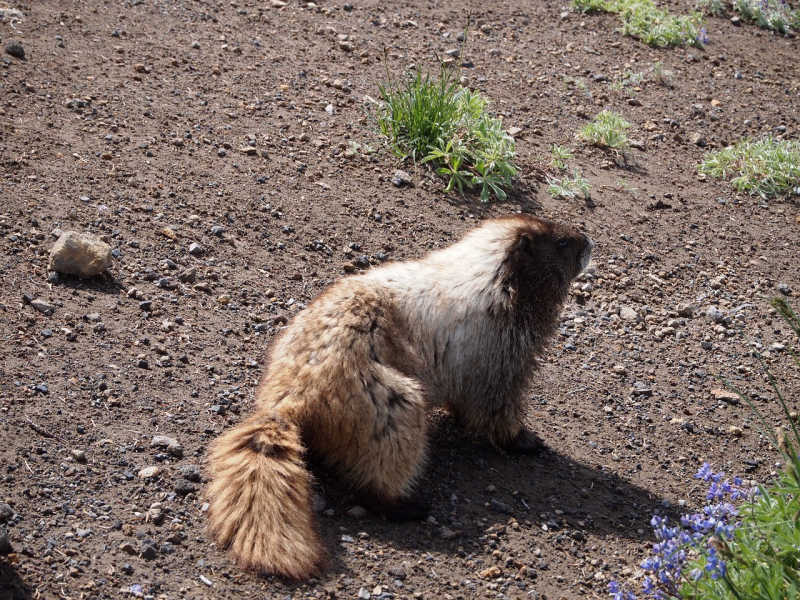
Other highlights on this hike are Myrtle Falls and Stevens-Van Trump Memorial. (If your goal is Myrtle Falls, you only need to hike 1-mile roundtrip)
The trail begins in the parking lot of Paradise, just behind the Visitor Center.
6. Hot Springs Nature Trail
Hot Springs is in the Ohanapecosh area – the shady side of the park. The nature trail is 0.5-miles and begins behind the Visitor Center.
You will stroll under towering evergreens to your destination, the waters of Ohanapecosh Hot Springs.
7. Grove of the Patriarchs
Just west of the Stevens Canyon Entrance is the 1.3-mile Grove of the Patriarchs. The trail has practically no elevation gain and offers interpretive panels that introduce the forest giants.
The highlight of this trail is the Ohanapecosh River and the 1000-year-old Douglas fir and western red cedar.
No, I take that back. The real highlight is the suspension bridge. It has a nice bounce, giving this family-friendly hike a ‘Swiss Family Robinson’ feel. The trail is designed to bring you back across the bridge, giving you two chances to feel like an adventurer.
8. Sourdough Ridge Nature Trail
Besides having the coolest name, Sourdough Ridge is a 1.3-mile roundtrip. It’s the perfect hike for alpine scenery. On a clear day, you will see Mount Baker, Glacier Peak, and Mount Adams.
Sourdough Ridge is in the Sunrise area. Road conditions can be dicey (aka icy) until July.
9. Carbon River Rain Forest Nature Trail
A rare sighting of a rain forest on the high alpine slopes. The trailhead is at the Carbon River Entrance and is 0.3-miles roundtrip.
10. Old Mine Trail
After hiking the Carbon River Road for 1.2-miles, you will take a spur trail 0.25-miles to a gated mine entrance for a little Mt. Rainier history hike.
To see current trail conditions visit the NPS website.
Pets and bicycles are NOT allowed on park trails.
More advanced hikers and mountaineers see NPS information on Wilderness permits and use of The 93-mile Wonderland Trail.
A full list of Mt. Rainier trails.
Two
Waterfalls
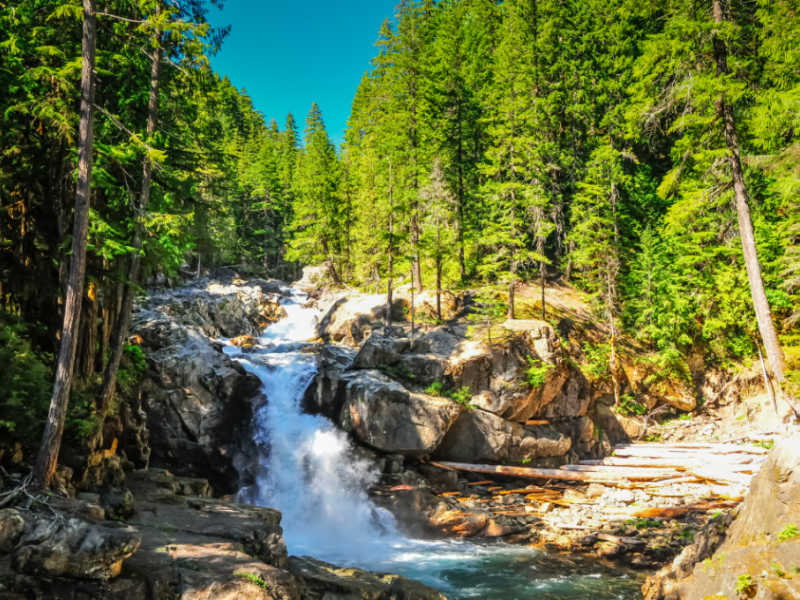
4 Waterfalls to see at Mt. Rainier National Park:
1. Narada Falls
The view is accessible by car – the top of the falls sits at parking lot level.
For a better view, a 0.2-mile roundtrip walk will bring you to a viewpoint at the bottom. (Note: The trail can be slippery)
2. Myrtle Falls
Located on the Skyline Trail (see above), Myrtle Falls’ trip is a flat, paved 0.8-miles. The trail begins just behind the Visitor Center at Paradise.
3. Comet Falls
Visiting Comet Falls is for the big boys (and girls). 1300-feet of elevation gain over 1.9-miles is no joke – because you also have to climb back down, which can be just as challenging.
However, this is the tallest waterfall in the park you can reach by trail if you’re game. Your reward is a stunning 320 feet of water.
4. Silver Falls
If you have your heart set on seeing waterfalls, but don’t feel up to the steep trek to Comet, try the Silver Falls trail.
A 2.7-mile loop takes you to a 40-foot waterfall cascading over a series of ledges.
Three
Lakes
Reflection Lakes
Named for the mirror image of Mt. Rainier, you can catch it on the surface. Just don’t bet the farm – conditions have to be perfect to score that photo.
The cluster of lakes sit near the road; a short path connects them, it’s worth getting out of the car for a closer look.
Tipsoo Lake
An alpine lake, accessible by car. Drive up and around the lake to a large pull-out for beautiful views.
Tipsoo is famous for being photogenic.
(Note: Naches Peak trail leaves from Tipsoo Lake)
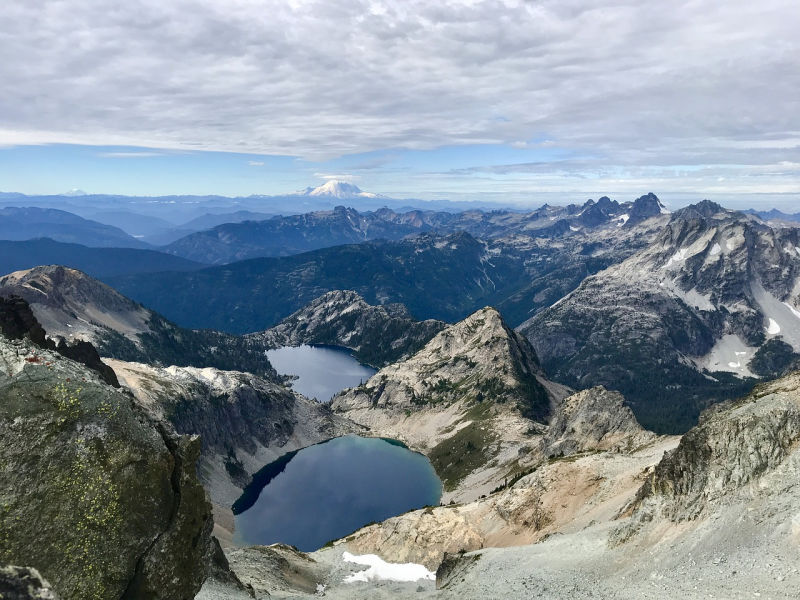
Four
Longmire
Longmire is the original hub of the park. Back in the day, it featured a hot spring, hotel, and the first visitor center.
Plan to spend 2-3 hours in the Longmire area. The Trail of Shadows (see above) starts here.
Also, stop by the Longmire Museum and the historic National Park Inn.
Five
Wildflowers
When is the best time to see wildflowers at Mt. Rainier National Park?
In Mt. Rainier National Park, wildflower season begins in June after the snow melts in the subalpine meadows. The wildflower season peaks in July and August.
The park offers several resources to help you. Check out the Mount Rainier Wildflower bulletin for quick two-page photo identification.
Check out the extensive online Wildflower Guide – which helps you pinpoint by location and color.
For even more help, purchase a wildflower guide book in one of the NPS park stores.
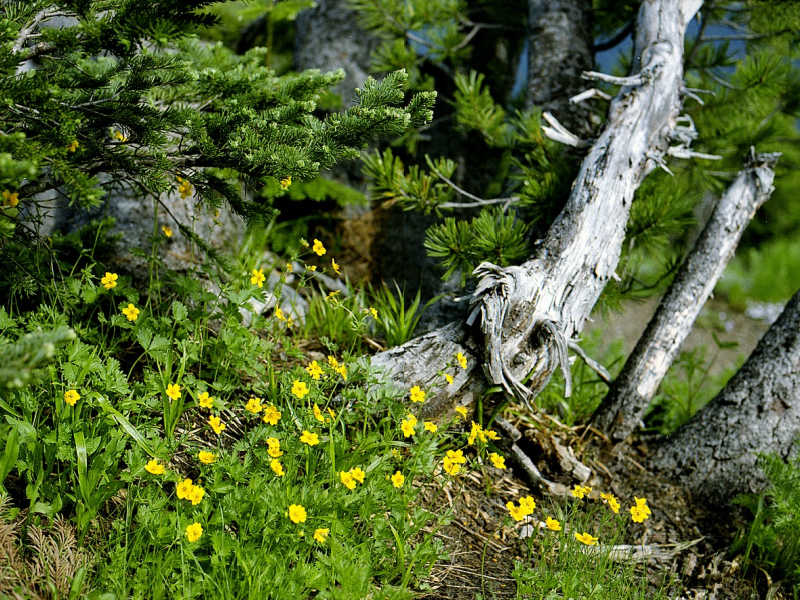
Six
Paradise
The Paradise area of Mt. Rainier is one of the most popular destinations in the park.
The impressive Paradise Inn is one draw.
You will also find the Jackson Visitor Center – a key stop for park information and ranger help.
A picnic area and restrooms are also useful.
Paradise is the jumping off point for the Skyline Trail (see above).
Finally, Paradise is the center of winter recreation on Mt. Rainier.
Seven
Scenic drives
There are many routes to see the majestic Mt. Rainier National Park:
Loop 1: Circle the mountain
147 miles
5 hours
Open late May – October
Get a map and guide from Visit Rainier.
Loop 2: Take the Scenic Byway
129 miles
3 hours
Open late May – October
Get a map and guide from Visit Rainier.
Loop 3: Follow the road to Paradise
83 miles
2.5 hours
Open mid-June – October
Get a map and guide from Visit Rainier
Eight
Winter recreation
Snow shoeing
The rangers lead snowshoe walks on Saturdays, Sundays, and holidays at 11 am and 1:30 pm. These guided walks last about 2 hours.
You will need to sign up at the Jackson Visitor Center (Paradise) one hour before the walk – it’s first come, first served.
Cross-country skiing and snowboarding
A minimum of 5-feet of snow is necessary (recommended?) for skiing and snowboarding in the park. For current conditions and trails, advice check with the rangers at Jackson Visitor Center (Paradise) on weekends and holidays and Longmire every day.
Tubing
The snow play zone is at Paradise. Depending on snow accumulation, it opens in late December – mid-March.
This is the only place sledding and sliding are allowed in the park.
Flexible sleds, inner tubes and saucers are allowed. Toboggans and sleds made of hard, inflexible material are not.
Winter Camping
OK…if you want to! Here’s the link for more information on camping in the park when it’s freezing.
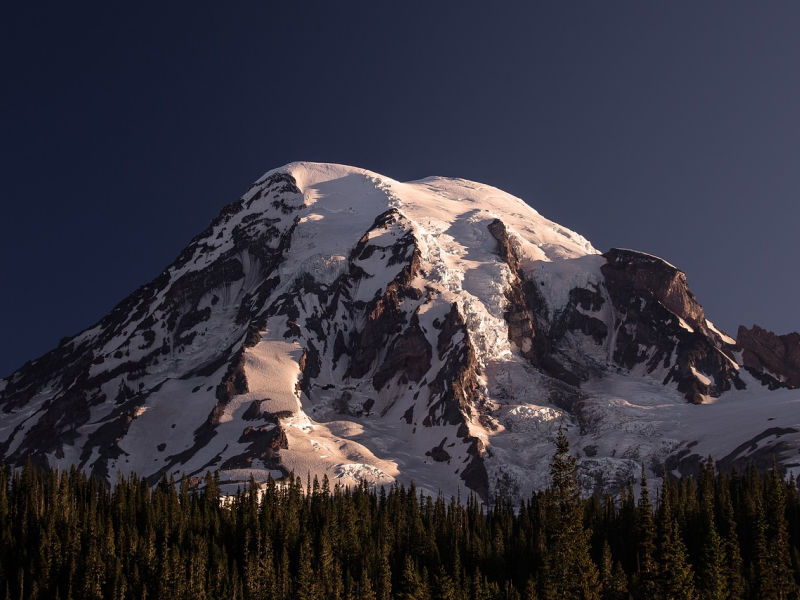
| Ashford, WA | 23 Miles |
| Eatonville, WA | 43 Miles |
| Packwood, WA | 81 Miles |
| Centralia, WA | 93 Miles |
| Seattle, WA | 107 Miles |
| Longview, WA | 109 Miles |
| Yakima, WA | 155 Miles |
| Portland, OR | 156 Miles |
Get an education at Mt. Rainier National Park
Youth activities
Student guide
A virtual guide provided by the NPS includes; Animals, Plant and Life Zones, Mount Rainier as a Volcano, Glaciers, Mount Rainier History, Fast Facts, Maps, Adventures and Hikes, and Webcams.
Select an area of interest and explore.
Activities for Kids
The activities section currently offers 7 projects to try.
Examples:
Ranger round-up – students learn about the different jobs within the park.
Inspiring mountain – art activity
Backyard Bird Bingo
Plant Scientist – tracking the changes in your neighborhood plants
Distance Learning Programs
Three curricula offer a teacher’s guide, activities, and worksheets – free and available for download.
Aimed at students 5-13, you will find one guide on habitats and another on volcanoes.
The third project is an initiative from the park system called ‘Ask a Ranger’. Children (and adults) are encouraged to ask a ranger a question about Mt. Rainier. A full project guide is provided for this program.
Nature guides
Beautifully photographed virtual nature guides are available for every type of flora and fauna relevant to Mt. Rainier.
You will find mammals, fish, reptiles, amphibians, wildflowers, birds, trees, and lichen. As well as glaciers, waterfalls, and volcanic features.
Many of these nature guides will lead you to even more tools – like species checklists.
History & Culture
Mt. Rainier is significant to Washington’s history and development, as well as National Park history.
Read all about it in this section of the parks website.
Follow your interests to explore archaeology, early explorers, how the park began, the early years of development, how The Great Depression and WWII fit into the park’s story, and the history of mountaineering in the park.
Everything you need to know about visiting Mt. Rainier National Park
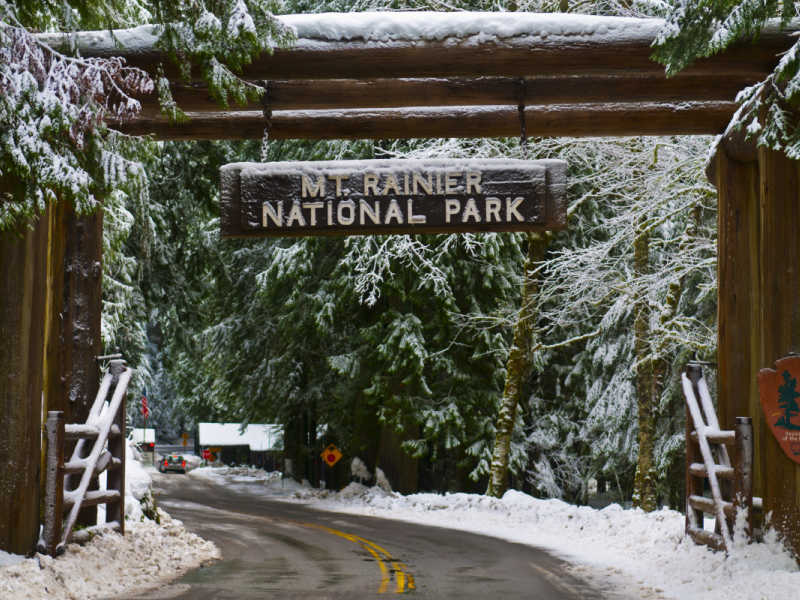
Where
Where is Mt. Rainier National Park?
Mt. Rainier is in Washington State. The park is situated in the west-central region of the state, south of Seattle and east of Olympia.
When
When is the best time to visit Mt. Rainier National Park?
Late summer to early fall is the best season to visit Mt. Rainier National Park. Avoid weekend crowds by visiting Monday – Thursday. Finally, get an early start. The park fills up by noon.
Of course, when you visit Mt. Rainier depends a lot on what you want to do. Mt. Rainier is open year-round. Summer is the busiest season, with wildflowers at their peak in July and August. In winter, many trails are covered in snow – in some areas until mid-July. But winter offers snow recreation. And if snow is your thing, you will want to brave the elements to enjoy it.
For up-to-date info on seasonal hours see the NPS planning page.
Cost
Admission to the park is $30 per vehicle (includes passengers). The pass is good for 7 consecutive days.
If you plan to visit any other national sites within the year, I highly recommend an America the Beautiful pass – for $80/year.
The fee structure is detailed. It’s best to read over the options. Free passes are available to some groups, discounts for others.
Mt. Rainier has its own annual pass, in case you want to return throughout the year.
Find out all the fee and pass info here.
Accessibility
All official Mt. Rainier accessibility information can be found on the NPS website.
How long
How long should you plan to visit Mt. Rainier National Park?
One day is long enough to experience Mt. Rainier National Park. Begin at Longmire and continue your 80-mile tour through Paradise, Ohanapecosh, and finally, Sunrise.
If you want to meander and take a few day hikes, select one area of the park and spend your day exploring it fully. The park is divided into 5 main sections – Carbon River, Ohanapecosh, Paradise, Longmire, and Sunrise. Each area has a lot to offer.
The park and nearby towns provide a variety of lodging options (see below). Spending a few nights will allow you to see the entire park, take in all the highlights, and enjoy multiple hikes.
Near Mt. Rainier National Park
Where to stay
Accommodations near Mt. Rainier National Park
Paradise Inn
Built in 1916, rustic style lodge with 121 guest rooms.
National Park Inn
Open year-round with 25 guest rooms.
We are not fans of the National Park Inns. If you are intrigued and want to experience history for yourself, read the inns reviews carefully to know what to expect.
And whether you stay over or not, stop by and visit the lobby and common areas. The structures are historical and beautiful.
You can read more about our experience at the Crater Lake Lodge here.
Nearby towns of Ashford, Packwood, and Enumclaw
Offering the usual array of motels, private vacation rentals, and camping. These are all small towns, so hotel/motel options are limited.
Start by searching a major directory like Hotels.com or Bookings.com to get an idea of what’s available.
You can also look for private options on Airbnb or VRBO.
The park has three drive-in/RV campgrounds. Cougar Rock and Ohanapescosh have a reservations system. White River is first-come, first served.
Where to eat
Places to eat near Mt. Rainier National Park:
Paradise Inn (food available May – early October)
Paradise has a restaurant and a small cafe.
Paradise Camp Deli in Jackson Visitor Center.
National Park Inn (food available year-round)
Longmire restaurant serving breakfast, lunch, and dinner.
Sunrise Day Lodge Snack Bar (food available July – September)
Eat in nearby towns
Ashford
Packwood
Enumclaw
Again, these are small towns with a handful of eateries. Keep in mind businesses in these towns may close relatively early – don’t expect any late-night dining.
Our recommendations:
Bring your own food. Pack a delicious picnic and enjoy the scenery.
Plan a Trip to Washington:
Check out our complete guide to planning your next trip to Washington State.

